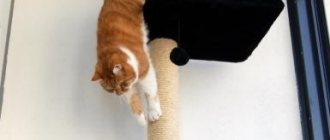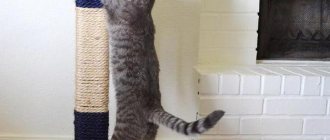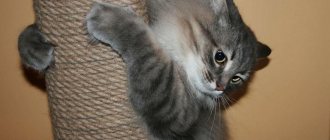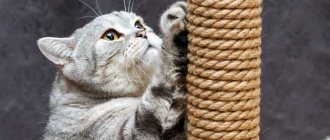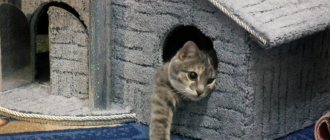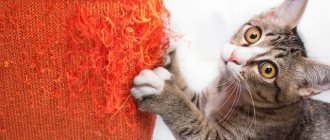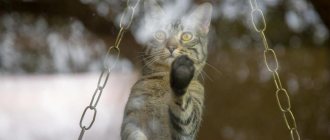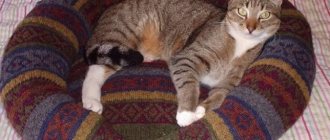Most often, preparations are made in advance for the arrival of a kitten in the house. Not only the breed is thought through, but also the details that can make his life as comfortable as possible - dishes, toys, litter box. However, are just these items enough? As cats grow older, an important need arises - the need to sharpen their claws. And so that your dream of having a cat does not turn into disappointment, you should still pay attention to the need to have a scratching post in the house. If you don’t want to buy one, then a scratching post for cats can be made with your own hands from available materials.
Types of scratching posts: floor, column, corner
Why do cats sharpen their claws?
Once upon a time, cats were wild animals, and also predators, which they remain to this day. In the struggle for survival in a cruel nature, they had to carefully monitor their “weapons” - their claws. After all, whether the hunt would be successful depended on how sharp they were.
The danger of starvation or death had passed, but the primary instincts remained. Cats continue to sharpen their claws, clearing them of the keratinized top layer in order to free the overgrown young plate. And for this you need a fairly hard surface, like trees, for example.
Today, the habitat of cats is no longer wild forests, but a cozy apartment, and trees can easily be replaced with furniture or wallpaper. All a person can do is offer cats a worthy replacement in the form of scratching posts.
In addition, sharpening claws is a physical exercise, and the location of the claw depends on which muscle group will be involved in the process. Therefore, it is advisable to provide the animal with more than one “equipment”, but to create a mini-gym from several items.
Design features
Scratching posts for cats can have different designs. You've probably seen both ordinary planks and complex multi-level houses in pet stores. But these are not all possible forms. The information below will help you understand what shape a scratching post comes in.
Column with platform .
This is a scratching post that has a special platform on the top, designed for the pet to rest comfortably. Usually it has a fairly stable base, a high column wrapped in a thick cord, and on top there is a platform. To sharpen the claws, a post about 70 cm high is used, and it is better to make the platform soft with a hard base. Wall variation . The simplest version of a scratching post. It has the shape of a board wrapped with cord or trimmed with carpet. It is fixed directly on the wall, most often on the door frame at the height required for the cat. It doesn’t take up much space, it’s inexpensive, and it’s very easy to do it yourself. Suitable for pets who prefer to sharpen their claws on walls.
Claw houses . The most expensive and difficult option to make yourself. This is a large structure, especially if it is multi-tiered, and is not suitable for installation in every apartment. It is quite expensive in the store - the price of some models can be more than 10 thousand rubles. However, there is no guarantee that the cat will appreciate such costs and will use the product.
Angle sharpener . This scratching post has the shape of a corner or a book, as is not difficult to understand from the name. Suitable for those whose cats tend to tear off the corners of furniture or walls. The product will definitely “lie” on the corner in the place chosen by the animal and cover the fabric or paper covering. An improved version of the usual wall-mounted scratching post.
Floor scratching post . This scratching post is simply installed on the floor; it can be a board with a wrapping/carpet or a wave-shaped product with a surface for sharpening claws. Suitable for those breeds that do not like to climb somewhere and stretch upward while sharpening their claws.
Scratching post-shelf for cats
On a note! Experienced cat owners report that it is not worth combining a scratching post with a house. Most cats will not appreciate this option, since the place where they sleep and the place where they mark their territory and sharpen their claws should be in different places. This is laid down on an instinctive level. For safety reasons, wild animals do not mark their dens.
More complex options for scratching posts
Separately, we can say about cardboard scratching posts . These are the simplest and cheapest products that are ideal for small kittens as they are soft enough for their claws. They are made from thick packaging cardboard. You can make them yourself very quickly. There are such products on sale, they are very cheap, but you can’t find them in every store.
Cardboard cat scratching post
And now we suggest you study several master classes on making different types of scratching posts. Thanks to the photo, you will be able to evaluate how difficult/easy it is to create this or that model, understand your financial and time costs, and choose the best option for yourself.
Articles on the topic
DIY dog bed
Types of scratching posts
Felinologists, experts in the anatomy and physiology of domestic cats, recommend acquiring at least three different types of cat cats and placing them where the animal most often stops to sharpen its claws.
The simplest and most affordable types of claws:
- corner;
- wall;
- pillars;
- floor;
- complex.
They are easy to make with your own hands, spending a minimum of time and money. This can be a board, a sheet of chipboard or plywood, wrapped in thick fabric, burlap, a piece of old carpet or coarse twine purchased at a hardware store. If there is a container made of corrugated cardboard (corrugated cardboard) left in the house, then it can also be used.
Wall-mounted nail clipper with fastenings
Wall hanging nail clipper
There is another type of device where cats can sharpen their claws - this is a complex. You can build it for one pet or for several. It requires more space and is more difficult to manufacture.
Before you start making a scratching post with your own hands, it is advisable to observe what your pet likes best. One likes to climb almost to the ceiling and look around his possessions from there. Another is comfortable in a cozy house with a small opening to the outside. The third, like a true athlete, is ready to overcome obstacles for days on end, jump and jump over everything that catches his eye. With a little ingenuity, you can captivate your pet so much that he will not see anything around him except the play complex.
Frequent errors in manufacturing and assembly
- Often, when making a scratching post, some mistakes are made, the most basic of which are insufficient stability, incorrect materials, ill-conceived design.
- Any structure must be balanced and securely screwed. If it falls, the cat will get scared and stop using it.
- Purchasing the cheapest ready-made scratching posts. For their manufacture, the most fragile, low-quality materials are used, which, with frequent use, quickly become unusable. Such products can lead to injury to the cat, its paws, and claws.
- The owner thinks that the cat itself should understand the purpose of this new object. She needs to be taught, shown what the animal should do with her, and to interest the pet in every possible way.
- Wrong sizes. When developing drawings and diagrams, the owner does not take into account the size of his animal, its habits, habits, and character. The pet may simply not like such an item, and sometimes it does not correspond to its dimensions or weight.
A house for a Maine Coon should be larger than, for example, a house for a British or other breed.
The animal cannot use it comfortably. It is easier to train a small kitten than an adult who is used to sharpening her claws elsewhere. Such an animal must get used to new furniture gradually.
Corner
Can be installed on both external and internal corners. Corner scratching posts, like wall-mounted ones, unlike floor-mounted ones, require durable fasteners. The distance from the floor should be chosen based on the size of the pet, and installed in the places most favorite for scratching.
Corner scratching post with platform
Corner scratching post
Simple corner scratching post
You can also install the corner structure on furniture. An aesthetically executed scratch will not greatly spoil the appearance of a sofa or chair, but it will protect against the claws of an animal if it gets into the habit of sharpening its claws in this particular place.
A corner scratching post on the sofa will protect the upholstery from claws
How to make a beautiful corner scratching post
Option 3: ombre with a toy
This design has much in common with the first option. However, before you wrap the rope around the beam, it must be properly painted. To do this you need to use permanent markers. One end of the rope is soaked with a large amount of dye, after which one is suspended at full length, the dye slowly descends and an ombre is obtained.
Ordinary paint is not used, since the cord will be less elastic and durable. Alternatively, beet juice can be used. The toy is attached to a separate thread, which is wrapped with sisal on top.
Wall mounted
The most economical option and easy to implement (see photo above). Fastening is carried out to the wall in the right place, but you can simply hang it. The material may be different: wood, twine, etc.
How to make a wall-mounted claw clipper
A stronger and more durable claw scraper would be a piece of wood. Cleared of the remaining bark, sanded and wrapped in places with thick twine, the tree will turn into a necessary item for the animal. It should be taken into account that the wood is quite hard and not all cats will like it as a “sharpener”.
To make your own wall scratching post you will need:
- plywood or board 20 cm wide and 50 - 60 cm long;
- rope or fabric;
- glue, stapler;
- glue gun or just glue;
- screwdriver
You can make the board yourself or choose the right size. It is not necessary to blindly follow the sizes - the main thing is that the animal is comfortable in height and width. You can also use corrugated cardboard glued in several layers as a base. You just need to think about a strong mount to the wall. Using a screwdriver, drill a hole in the board for fastening. If you need to prevent swaying, then make two holes at the top and bottom or both at the top.
Size doesn't really matter. The main thing in a scratching post is to fulfill its direct function.
Winding the twine around the base, apply glue in some places with a gun and lay the thread on it. This is necessary to prevent the wound rope from moving. If you don’t have such a gun, you can use simple glue, applying enough of it to attach the rope.
As fabric for the scratching post, you can use drape, overcoat cloth, Chelsea cloth, as well as fur or carpet. In this case, you can secure the material from the reverse side with a stapler.
Suitable materials
What can you use to make a scratching post for your pet? It is advisable to select natural materials - some synthetic ones have a certain smell that is unpleasant to animals and repels them. But if the cat is calm about such scents, then you can use synthetics.
The easiest way to make such a device is to place pieces of cardboard on a pin
Any scratching post, even the simplest one, has some kind of base. It must be strong and stable enough so that the animal is not afraid to use the product and it is convenient for him to sharpen his claws. Wood is usually used as a base (for the simplest scratching posts or more complex options) or pipes used for arranging the sewer system (for scratching posts-houses). You can also take a cardboard reel from linoleum and other similar products. They should be thick enough to make a good base for a scratching post.
DIY wooden scratching post
But the most important element of any scratching post is the part on which the cat will sharpen its claws. This should be a fairly strong, but not rough material that will help the animal effectively remove the falling parts of the claw. It is best to choose fibrous materials, but such that there is no risk of the claw getting stuck in the pile. These can be materials such as cardboard, jute cord, carpet or a piece of an old woolen carpet, sisal, ordinary wood and much more .
A simple cat scratching post made from cardboard
Pillars
The scratching post is often used by cat lovers due to its versatility. A cat can sharpen its claws on both horizontal and vertical surfaces, climb up, and chase a toy attached to a post. If you fix a horizontal platform on top of the post, then the issue with the bed will also be resolved.
Simple scratching post
Scratching post with toy
Floor-standing scratching post with horizontal scratching post
Sometimes cats tear up furniture legs, most often table legs. Here you can improvise - wrap it with twine and you will get a ready-made claw blade.
How to make a scratching post
To make a scratching post, any available material is suitable - a board or plywood for support, a small block or a piece of plastic pipe for a post. Having screwed the beam to the base using self-tapping screws or secured with metal corners, you need to tightly wrap the beam with twine or sisal rope (can be bought at Leroy Merlin) using a glue gun for fastening.
We wind the rope tightly around the scratching post bar of the post
Advantages of sisal rope: high strength, durability, natural material
The base can be painted, sealed with a piece of thick fabric, carpet, or the same rope can be laid in a spiral, glued for strength. The main requirement for such a structure is stability. It is necessary to carefully calculate the proportions of the height of the column and the area of the base, or “peep” the dimensions of finished products in pet stores.
Horizontals
They are divided into shelves for walking, areas for resting or placing a “birdhouse” and hammocks.
The platforms can also serve as steps to make it easier for your pet to climb to the very top of the structure. They are made from plywood. Sheets Ш1 or Ш2 are suitable, any grade except IV (falling out knots and cracks will affect the strength), birch is better than pine needles (cats are sensitive to odors), moisture and fire resistance do not matter.
The recommended thickness is from 6 (if you have a not too large cat) to 10 mm. Covering them with a covering for the claw point is worth it if the structure will be on the floor. In other cases it is a matter of taste. The technology is the same as for vertical surfaces.
Floor-standing
Perhaps the simplest designs to implement. They can be of various shapes and located on the floor or at an angle to it. In addition, they can be combined with some other elements, columns, houses.
How to make a floor scratching post
We suggest making a floor scratching post from corrugated cardboard yourself with step-by-step instructions. To work you will need:
- construction tape,
- pencil,
- ruler,
- scissors or wallpaper knife,
- glue.
You can take a box with low sides for the mold, but you can do without it by securing the finished structure with cardboard tape around the perimeter.
Necessary tools for making a scratching post
Place the strips tightly in the box
Cut the cardboard into strips to fit the length and height of the box. Glue the strips with glue and connect them. It is advisable to use glue with a minimally noticeable odor, for example, PVA. After drying, the nail clipper is ready for use.
Simple round corrugated cardboard scratching post
Corrugated cardboard bends quite easily, so the second version of the scratching post is a twisted long strip secured with glue or adhesive tape. In this case, the size can be chosen at your discretion, and in case of long-term use, simply add layers as the shaggy consumer grows.
Crafts made from corrugated cardboard
The simplest scratching post for cats is made from corrugated cardboard. To do this, unfold an ordinary box and cut it into strips 8-12 cm wide. Then they are either glued together in layers or rolled into a “snail”. It is often recommended to fasten the layers together with PVA glue, but pets lick and chew such products, so make a starch paste at home.
Game complex
In pet stores you can find large play complexes, sometimes under the ceiling. However, it is possible to construct such structures with your own hands. For such a project, you first need to develop a diagram, make a sketch, decide on the dimensions, and tie them to the place where it will be located. If you can’t make a drawing of a scratching post yourself, you can resort to the help of friends or look for something similar on the Internet.
Game complex project with dimensions
The advantage of creating a gaming complex yourself is its lower cost, based only on the price of consumables, and the ability to choose a color scheme that fits perfectly into the interior.
You can start with a small module, making a simple post-claw scratching post with an open bed, a toy and an inclined platform. All elements must be stable, well fastened to each other, and the joints and fastening fittings must be carefully hidden under a protective layer of fabric or thick cord.
Wall-mounted play complex for cats with scratching posts
Complex with a set of elements for cats
A simple complex for cats
When the cat masters the toy, you can add a house for privacy and several posts, connecting them with rope ladders, hammocks, planks, and large-diameter pipes. It all depends on your imagination. Place several open areas on the posts at different heights - at a safe distance from each other for jumping. It is better to immediately select the base for such a complex of the required size, designed for additions. This will increase the stability of the finished structure.
What models are there?
It would seem that there is nothing complicated about it: bring a log or board from the street, put it against the wall - and you don’t have to worry about the safety of the furniture and wallpaper. In reality, everything is more complicated. Each cat has its own character and habits. Therefore, you need to select a scratching post individually, after first observing your pet.
There are several varieties suitable for Maine Coons:
- Scratching post-bed.
- Column.
- Vertical scratching post mounted on the wall.
- Playhouse.
Getting your cat used to the scratching post
An animal should be accustomed to a scratching post from the first days of its appearance in the house. Same as for the potty. If the baby is taken from the mother, then there will be much fewer problems with him. To avoid any problems at all, you can prepare the scratching post in advance and keep it next to the cat’s mother for a while. In the new home, the kitten will not only already know where to go to satisfy its physiological needs, but it will also be much easier to cope with the stress of separation, feeling the familiar smell from the scratching post.
Pets from the shelter are often familiar with the scratching post, so at home it is enough to build an analogue that is familiar to them and the problem will be resolved. But with cats picked up on the street, and quite old ones at that, you will have to tinker. Animals accustomed to complete freedom often refuse to take anything into account even after the owner has achieved a result. This is not a sign of obstinacy or bad character, it is just a different way of life than a person, which we often forget. The owner will have to work hard.
You shouldn't have high hopes for valerian or catnip. Animals, like people, each have their own character. And what is sweeter than honey for one person does not evoke any emotions for another. If herbs and spells do not help, observe where your pet prefers to sharpen its claws. What kind of surface is it - horizontal or vertical? What does he like best - wallpaper, upholstered furniture, door upholstery or wall plasterboard. And then just a little imagination and love for this shaggy terminator is enough for the previous order to be established in the house. You can also play on his primary instincts. Place a scratching post that smells like another cat in the right place - success is guaranteed from the first days. The animal will carefully “scratch” the marks of a competitor who has encroached on its territory.
Top part
We have already stated that the pet chooses the upholstery. How to line a cat house or cover a surface for sharpening claws:
- carpet - cheap fabric for a scratching post, average maintenance, technically the most difficult to replace;
- jute rope - inexpensive, easy to replace, short-lived;
- sisal - the most durable, but also expensive;
- corrugated cardboard - cheap, but short-lived;
- with a wooden block - few people like it, but the labor costs when working with it are minimal.
Animals, of course, do not differentiate between sisal and jute (by the way, if you decide to try jute and like it, you can then replace the rope with sisal). Few people prefer unsanded wood, but sometimes it is the ideal scratching post for cats.
How to discourage a cat from sharpening its claws in a “forbidden” place
In order for your pet to quickly switch to the scratching post, it is necessary to create unpleasant conditions for him in his favorite place for scratching. First of all, a certain smell will help. Animals have a more highly developed sense of smell and some aromas are categorically unpleasant to them. The smell of alcohol, for example, or perfume. Cats don't like the smell of all citrus fruits. You can purchase a special spray based on aromatic oils at the pet store. Surfaces should be treated with it until the pet completely gives up the desire to scratch them.
Beaphar Stop It Cat Spray for repelling cats from furniture
You can speed up the weaning process by throwing a slipper next to the wrong object at the moment when the cat tries to scratch it. Usually animals quickly abandon places where they are supposed to be in danger. A loud bang, a stern hail, and wrapping furniture in cellophane are also effective.
Many people recommend “water procedures” from a spray bottle, but this is possible if a cat is somewhere nearby trying to sharpen its claws, and the owner is sitting fully armed, waiting for her. Everyone can invent a way to dare an animal themselves, knowing all its pros and cons.
Assault is strictly unacceptable, because cats are easily stressed and such “education” will not lead to the desired result.
Six effective tips
Below are some helpful tips that will help you succeed in training your kitten to use a scratching post:
- Encourage your pet when he independently approaches the stand and begins to cling to it with his claws. You can praise, pet or give a treat.
- Do not grab your pet by the paws and force him to scratch the scratching post. Even if the owner does this carefully and gently, the kitten still will not understand what they want from him. He won't like it. The animal will try to escape from your hands, and the scratching post will already be associated with something unpleasant
- Try to attract your cat with mint. Do not use valerian (valerian), it, like a drug, distorts behavior and dulls the cat's instincts. Take a small amount of catnip and sprinkle (spray) the counter. This product attracts cats well, they begin to rub, purr and release their claws with pleasure.
- When playing near the counter, be attentive and consistent in your actions so that your pet clearly understands what they want from him.
- Do not play with the animal near curtains or furniture. By grabbing an object, the kitten will think that it can scratch other nearby things.
- Cover the corners of the sofa and other furniture with something rustling, such as bags or foil, while training you to use the scratching post. If a cat pulls up the carpet, it should be removed until a useful skill is finally established in the pet’s behavior.
Should I have an onychectomy?
Finally, we should remind you about the operation permitted in some countries to remove the claws of domestic animals - onychectomy. Yes, this procedure will save the owners from a lot of trouble and preserve the furniture, but is it really harmless to the animal itself? After all, along with the claws, the front phalanges of the fingers are removed, which affects the functioning of the entire musculoskeletal system.
A cat is a fairly mobile animal and without claws it is doomed to endless injuries - there is nothing to cling to. She will not be able to climb onto a low surface; it will be difficult for her to maintain balance. After the operation, you may suffer from pain for the rest of your life, which is shortened by almost three times due to the disruption of your usual life. In addition, having lost its claws, the animal becomes more aggressive and tries to solve all its problems with the help of its teeth.
Is it worth purchasing used items?
Some owners make just such a decision in the hope of saving money. But this is a fundamentally wrong approach, because objects may smell like other people’s animals, which will most likely only scare away yours. And no one can guarantee the health and hygiene of the previous user of the accessory, thereby you risk infecting your cat with unpleasant diseases.
For creative people, creating a scratching post for your pet will only be a joy. You can completely rely on your imagination and come up with its design yourself. A creative approach to work will help you create an interesting and original household item that will adequately and harmoniously decorate the interior of the room.
What to choose - jute or sisal fiber?
So, both types are popular due to their affordable cost. This factor is quite significant, because winding a post requires several tens of meters of rope. But you should immediately pay special attention to the fact that no matter what material you choose, the scratching post will not last forever! Any thing wears out over time, and this product is no exception. The lifespan of the scratching post depends on the following parameters:
- How often does the pet use it?
- Breed of the animal (large representatives have a much larger nail plate).
- The quality of the scratching post.
Jute is made from the plant of the same name in the mallow family. Its fibers are mainly used in the textile industry, as well as for making ropes and burlap. Features of jute:
- Gray-brown fiber color.
- Softness.
- Smoothness (fibers do not stick out).
- Low cost compared to similar materials.
Sisal rope is much coarser than jute because it is made from raw fibers obtained from the leaves of the agave tree. This plant has unique qualities, which allows it to be used in a wide variety of industries, from food to construction. What features does sisal have?
- Quite a rigid structure.
- Light sandy shade.
- High wear resistance.
